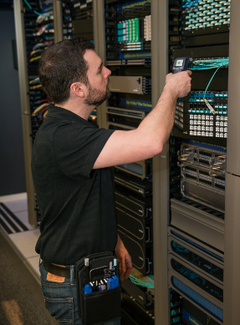Fiber Testing Methods and Types of Measurement
To assess the quality of a fiber installation, sign it off as ready for service activation, and ensure reliable on-going operation of a fiber link, some basic fiber test methods and tools should be used.
There are several important things to measure, assess and check:
Fiber End-Face Inspection
When two fibers are mated together, a key requirement is to ensure light passes from fiber to fiber without excessive loss or back reflections. What remains challenging is maintaining a pristine end face. A single particle mated into the core of a fiber can cause significant insertion loss, back reflection, and even equipment damage. Proactive fiber inspection is essential to ensure reliable fiber connections.

Fiber Continuity Test
When you test fiber optic cable networks, a visible laser source connected to one end of the cable can be used to verify the transmission to the opposite end. This type of fiber optic test is only intended to detect gross fiber defects such as macrobends. You can also test fiber optic cable continuity to determine whether the right fiber optic cable is connected to the right patch panel location.
A fiber identifier (FI) is a useful handheld fiber test tool that can identify and detect optical signals from the outside at any point along the fiber link. Fiber identifiers can be used to confirm the presence of traffic on a fiber as well as the direction of the transmission.
A visual fault locator (VFL) uses visible spectrum laser light to test fiber continuity as well as detecting fault conditions. The red-light source will be visible through the coating at the location of any fiber breaks or defective splices. For fiber runs longer than 5km/3miles or where access to view the fiber is limited, an OTDR can be used as a fiber optic cable tester to pinpoint any continuity issues.
Optical Loss Measurement
As the light source traverses the fiber, it decreases in power level. The decrease in power level, also called optical loss, is expressed in Decibels (dB).
Some may ask what the ‘correct method for fiber testing is’. The most accurate way for fiber testers to measure the overall optical loss in a fiber is to inject a known level of light in one end and measure the level of light at the other end, using an OLTS. Since the optical light source and power meter are connected to opposite ends of the link, access to both ends of the fiber is required for this method.
Optical Power Measurement
A power measurement is a test of the signal strength from the transmitter once a system is live or activated. An optical power meter will display the optical power received on its photodiode and can be connected directly to the optical transmitter’s output or on a fiber cable at the point where the optical receiver would be. Optical power can be measured in “dBm” units, where the “m” represents 1 milliwatt and the “dB” refers to decibels.

















